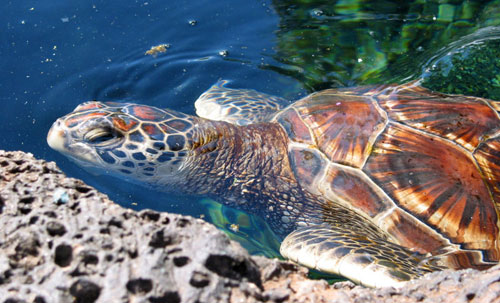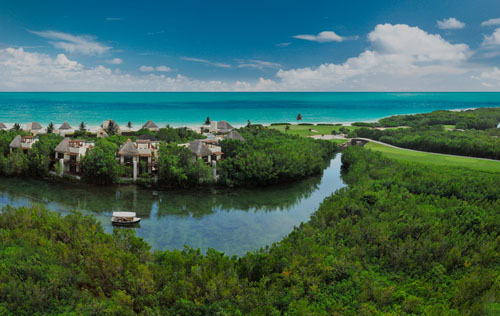Big Island of Hawaii’s Lee Coast – Kona Village


The Big Island is the farthest south, the youngest, and the biggest of the Hawaiian Islands. It is also the only one with three active volcanoes — Mauna Loa, Hualalai and Kilauea, which is the world’s most active volcano. It erupts continually, spewing out lava both night and day, and adding 500 feet to the coastline each year. An amazing sight to see.
Arriving at the secluded green paradise, called “Kona Village”, you feel you have reached a truly, tropical oasis. At Kona Village, you sleep in a palm-thatched hut call a hale (“HAH-lay”). Some of these hales (the more expensive) look out at their flawless lagoon; others (less expensive) overlook 5 ponds that are fringed with water birds and filled with tilapia nests. (Tilapia dig out small craters with their fins, which they protect fiercely).
Kona Village is blissfully quiet. During the day, you hear nothing but the cooing of zebra doves in rustling coconut palms. At night, you hear gentle wind. In the morning, you will be awakened by a joyful chorus of tropical birds.
The marine life is magnificent. The snorkeling is the equal of any place on earth. There are 12 species of healthy coral, 75 species of reef fish, moray eels, octopus, and manta rays.
If you do not watch your feet as you walk along the beach, you will trip over a huge green sea turtle, toasting on the hot sand to raise its body temperature. These gentle giants grow to 3½ feet, and can weigh up to 400 pounds. They lay their eggs on the French Frigate Shoals in the northernmost Hawaiian Islands in the summer, then come down to the Kona Coast to feast on seaweed in the winter.
These turtles will swim right underneath you, but don’t be tempted to help them out by scraping seaweed off their shells. If you do, you will be depriving some reef fish of its dinner. Turtles periodically will float lazily by the reef, so that yellow butterfly fish can come to vacuum off their backs. Humpback whales spend their summers in Alaska getting fat, and then come to Hawaii from November to May to mate. There are masses of them, and they are full of fun; the locals call the ocean at this time of the year “whale soup.” Gaze at the horizon, and within 10 minutes you will see at least one whale spout and then breach. One surfaced 100 yards from Cynthia’s kayak with a loud, “PAAAAH.”
There is an excellent beach crew on hand to organize your water activities. All are knowledgeable naturalists. Kayaks, wind surfers and snorkeling equipment are all free.
Boats go out daily for humpback whale and spinner dolphin spotting, and for scuba diving and snorkeling. In actual fact, the snorkeling off the beach cannot be beat, and you will see the humpbacks without going out in a boat.
Do go out in the spotter boat, however, in order to get a close look at the spinner dolphins. They will come right up to the boat, because they just love to play in the wake. All dolphins jump in the air; Pacific spinners jump, and then twirl around and around before splashing back. We counted 5 spins for one acrobatic fellow, and a little baby showed promise with 3 rotations.
You will also be able to eavesdrop on whale conversations from the boat, using a device called a hydrophone. Their eerie songs are occasionally used on the sound track of horror movies.
Twice a week they have a luau dinner at Kona Village, with traditional Hawaiian fare and entertainment. Guests can see a pig placed in the imu, or pit, with hot rocks and banana leaves, at 1 p.m. and then watch it taken out, roasted to perfection, at 6 p.m.
One night a week there is a paniolo (Hawaiian cowboy) barbecue, with entertainers who sing songs and tell stories about the olden days when the paniolo drove their cattle down to the beach and then into the ocean and swam their cows out to be lifted by cranes with huge straps which were put under the cows who were lifted onto the waiting ocean freighters. There is live Hawaiian music on the terrace almost every night. You will hear the famous “slack string” guitar: a guitar with the lowest E string tuned down to G and the other strings turned to a G chord. The sound is mellow and resonant and haunting.
One of the best petroglyph sites in Hawaii is right at the village. These rock carvings date back about 900 years. The ancient Hawaiians had no written language, so the priests would record important events by carving them into smooth lava. You will see many images of triangular shaped sails, which record journeys; images of men fishing; dots, which were probably ancient calendars; turtles and another animals.
Amazingly, there is a petroglyph of Captain Cook and his men, tied up in a sort of chain gang. Cook was killed in 1779, at a spot a half hour’s drive south of Kona Village. There is also a petroglyph depicting two other foreigners, Davis and Young, one American and one British. These two sailors, survivors of the slaughter of their shipmates, became advisors to King Kamehameha the first, the “George Washington “ of Hawaii, and helped him to conquer all the rival chiefs and unite the islands in 1795.
Kona Village is centrally located, so it is an excellent jump-off spot to see the rest of the island. We drove across the north side of the island one afternoon through the lush rolling fields of Parker Ranch (one of the largest cattle ranches in the U.S. at 350 square miles) to spectacular Waipio Valley which can be reached only on foot or by four-wheel-drive vehicles. The valley ends at the coast where the beaches are dramatic black sand. You can hire horses in the valley, ride to and gallop on these stunning beaches.




